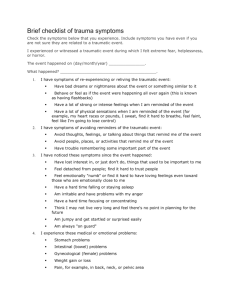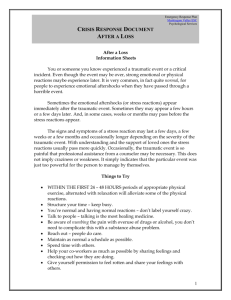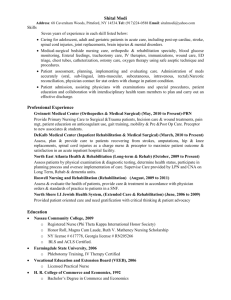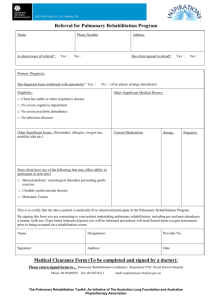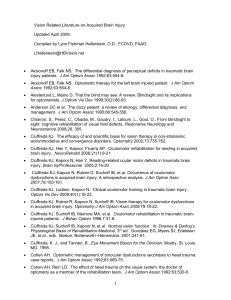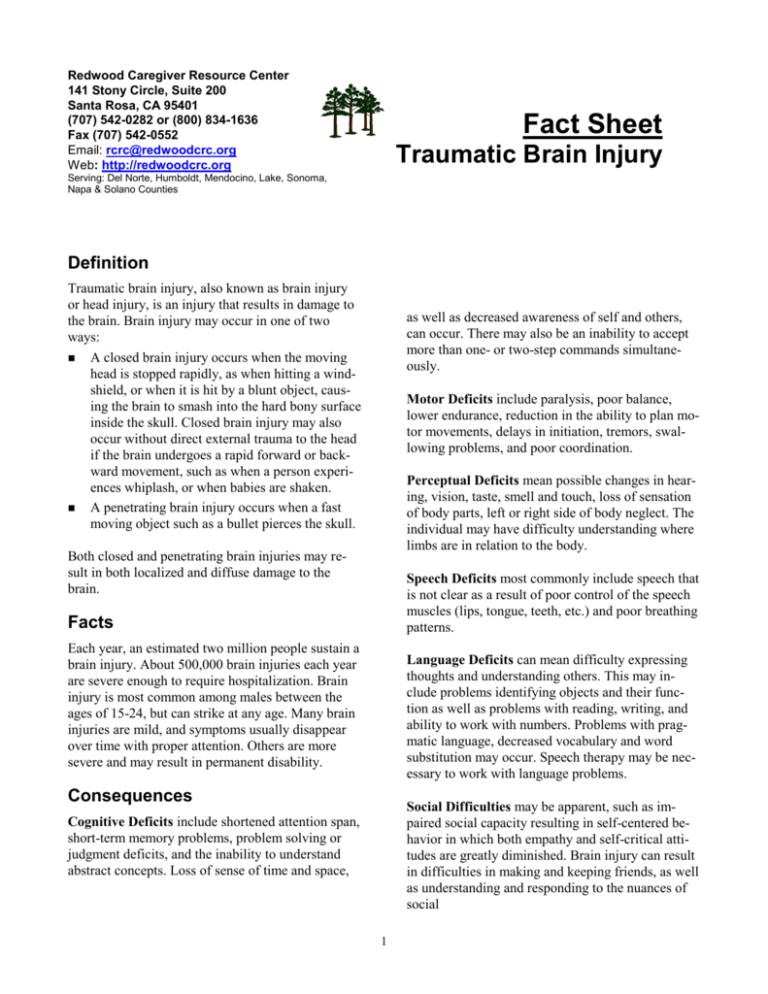
Redwood Caregiver Resource Center
141 Stony Circle, Suite 200
Santa Rosa, CA 95401
(707) 542-0282 or (800) 834-1636
Fax (707) 542-0552
Email: rcrc@redwoodcrc.org
Web: http://redwoodcrc.org
Fact Sheet
Traumatic Brain Injury
Serving: Del Norte, Humboldt, Mendocino, Lake, Sonoma,
Napa & Solano Counties
Definition
Traumatic brain injury, also known as brain injury
or head injury, is an injury that results in damage to
the brain. Brain injury may occur in one of two
ways:
A closed brain injury occurs when the moving
head is stopped rapidly, as when hitting a windshield, or when it is hit by a blunt object, causing the brain to smash into the hard bony surface
inside the skull. Closed brain injury may also
occur without direct external trauma to the head
if the brain undergoes a rapid forward or backward movement, such as when a person experiences whiplash, or when babies are shaken.
A penetrating brain injury occurs when a fast
moving object such as a bullet pierces the skull.
as well as decreased awareness of self and others,
can occur. There may also be an inability to accept
more than one- or two-step commands simultaneously.
Motor Deficits include paralysis, poor balance,
lower endurance, reduction in the ability to plan motor movements, delays in initiation, tremors, swallowing problems, and poor coordination.
Perceptual Deficits mean possible changes in hearing, vision, taste, smell and touch, loss of sensation
of body parts, left or right side of body neglect. The
individual may have difficulty understanding where
limbs are in relation to the body.
Both closed and penetrating brain injuries may result in both localized and diffuse damage to the
brain.
Speech Deficits most commonly include speech that
is not clear as a result of poor control of the speech
muscles (lips, tongue, teeth, etc.) and poor breathing
patterns.
Facts
Each year, an estimated two million people sustain a
brain injury. About 500,000 brain injuries each year
are severe enough to require hospitalization. Brain
injury is most common among males between the
ages of 15-24, but can strike at any age. Many brain
injuries are mild, and symptoms usually disappear
over time with proper attention. Others are more
severe and may result in permanent disability.
Language Deficits can mean difficulty expressing
thoughts and understanding others. This may include problems identifying objects and their function as well as problems with reading, writing, and
ability to work with numbers. Problems with pragmatic language, decreased vocabulary and word
substitution may occur. Speech therapy may be necessary to work with language problems.
Consequences
Social Difficulties may be apparent, such as impaired social capacity resulting in self-centered behavior in which both empathy and self-critical attitudes are greatly diminished. Brain injury can result
in difficulties in making and keeping friends, as well
as understanding and responding to the nuances of
social
Cognitive Deficits include shortened attention span,
short-term memory problems, problem solving or
judgment deficits, and the inability to understand
abstract concepts. Loss of sense of time and space,
1
interaction.
weeks. In fact, the outcome may remain unknown
for many months
or years.
Regulatory Disturbances include fatigue and/or
changes in sleep patterns, dizziness or headache.
There may be loss of bowel and bladder control.
Treatment
Rehabilitation of the individual with a brain injury
begins immediately. The initial life-saving treatment
may be provided by an EMT, emergency physician,
neurosurgeon or neurologist. As the person improves, a team of specialists may be used to evaluate
and treat the problems that result. This team may
include experts in rehabilitation medicine (physiatrists), psychiatry, nursing, neuropsychology, social
work, nutrition, special education, occupational,
physical, speech and language therapies, cognitive
retraining, pastoral support, activity therapy, and
vocational rehabilitation. The individual and his/her
family are the most important members of the team,
and should be included in the rehabilitation and
treatment to the greatest extent possible.
Personality Changes may be subtle or pronounced.
Changes include apathy and decreased motivation,
emotional lability, irritability, or depression. Disinhibition also may result in temper flare-ups, aggression, cursing, lowered frustration tolerance, and inappropriate sexual behavior.
Traumatic Epilepsy
Epilepsy occurs in two to five percent of all people
who sustain brain injury, but it is much more common with severe or penetrating injuries. While most
seizures occur immediately after the injury or within
the first year, it is also possible for epilepsy to surface years later.
There are a variety of treatment programs along the
continuum of care, including: acute rehabilitation,
long-term rehabilitation, coma treatment centers,
late rehabilitation, extended intensive rehabilitation,
transitional living programs, behavior management
programs, life-long residential, day treatment programs, independent living programs, and traumatic
brain injury programs within community colleges.
Epilepsy includes both major or generalized seizures
and minor or partial seizures.
Generalized Seizures, also called "Grand Mal," are
the most dramatic type of seizure. The person falls
unconscious to the ground. His or her body stiffens,
then jerks convulsively. The mouth, eyes, legs and
arms move. Urinary incontinence is common. After
several minutes, the jerking movements slow and
the seizure ends. The person will likely be drowsy
afterwards and may not remember the seizure.
Recommended Readings
Waiting to Clear, Brain Injury: Early Stages of
Recovery, Mary M. Castiglione and Cynthia Johnson, 1993, Pritchett & Hull Associates, Inc., 3440
Oakcliff Rd. N.E., Suite 110, Atlanta, GA 303403079, (800) 841-4925.
Partial Seizures, also known as "focal," may be
simple (during which the person is conscious but
temporarily loses control of movements or senses,
such as the uncontrollable jerking of an arm or leg),
or complex (during which the person appears to be
in a trance and may have isolated movements, such
as lip smacking or picking at their clothes). About
75% of seizures are partial, although many of these
seizures may eventually generalize.
Making Sense Out of Nonsense: Models of Head
Injury Rehabilitation, Ruth A. Whitham, 1994.
Available from HDI Publishers, 10131 Alfred Lane,
Houston, TX 77041, (800) 321-7037.
Sexuality and the Person with Traumatic Brain
Injury: A Guide for Families, Ernest R. Griffith
and Sally Lemberg, 1993, F.A. Davis Company,
1915 Arch Street, Philadelphia, PA 19103 (also
available from the Brain Injury Association).
Prognosis
The extent of an individual's enduring problems after a brain injury depend on many factors. Prompt
and proper diagnosis and treatment can help minimize some consequences of brain injury. However,
it is usually difficult to predict the outcome of a
traumatic brain injury in the first hours, days, or
Head Injury and the Family, Arthur Dell Orto and
Paul Power, 1994, G.R. Press, 6959 University
Blvd., Winter Park, FL 32793, (800) 438-5911.
2
3
The HDI Coping Series and the HDI Professional
Series on Traumatic Brain Injury, William Burke,
Michael Wesolowski and William Blacker, 1996
(revised), HDI Publishers, 10131 Alfred Lane, Houston, TX 77041, (800) 321-7037.
Resources
Family Caregiver Alliance
425 Bush Street, Suite 500
San Francisco, CA 94108
(415) 434-3388
(800) 445-8106 (in CA)
Web Site: http://www.caregiver.org
E-mail: info@caregiver.org
Through This Window: Views on Traumatic Brain
Injury, Patricia I. Felton (Ed.), 1992, Exceptional
Brain Trauma Survivors (EBTS), P.O. Box 500, No.
Waterboro, ME 04061.
Family Caregiver Alliance supports and assists
caregivers of brain-impaired adults through education, research, services and advocacy.
Injured Mind, Shattered Dreams: Brian's Journey
From Severe Head Injury to a New Dream, Janet
Miller Rife, 1994, Brookline Books, P.O. Box 1046,
Cambridge, MA, (617) 868-0360.
FCA's information Clearinghouse covers current
medical, social, public policy and caregiving issues
related to brain impairments.
Living with Head Injury: A Guide for Families,
Richard C. Senelick and Cathy E. Ryan, 1991, Rehabilitation Institute of San Antonio, Rehabilitation
Hospital Services Corporation Press, 1010 Wisconsin Avenue, N.W., Washington, D.C. 20007 (also
available from the Brain Injury Association).
For residents of the greater San Francisco Bay Area,
FCA provides direct family support services for
caregivers of those with Alzheimer's disease, stroke,
brain injury, Parkinson's and other debilitating brain
disorders that strike adults.
Traumatic Head Injury: Cause, Consequence and
Challenge, Dennis P. Swiercinsky, Terrie L. Price
and Lief Erick Leaf, 1993, Head Injury Association
of Kansas and Greater Kansas City, 1100 Pennsylvania Ave., Suite 305, Kansas City, MO 64105 (also
available from the Brain Injury Association).
Brain Injury Association
1776 Massachusetts Avenue, N.W., Suite 100
Washington, D.C. 20036
(202) 296-6443
(800) 444-6443 (Family Helpline)
The Brain Injury Association (BIA) is a national
advocacy and awareness organization which develops and distributes educational information on resources, legal rights and services. BIA is a centralized clearinghouse for information of all kinds regarding brain injury and provide referrals for state
associations across the United States.
Credits
Brain Injury Association, Brain Injury Resource
Center, an Interactive Multi-Media ComputerBased Resource Center, 1997.
National Institute of Neurological Disorders and
Stroke, February, 1989, Inter-Agency Head Injury
Task Force Report, Bethesda, MD.
Ontario Head Injury Association
P.O. Box 2338
St. Catharines, Ontario L2M 7M7
(905) 641-8877
Soren, S. and Kraus, J.F., 1991, Occurrence, Severity and Outcomes of Brain Injury, Journal of Head
Trauma Rehabilitation, 6(2), 1-10.
The Ontario Head Injury Association maintains TBI
INFO, a system of on-line information on traumatic
brain injury and community reintegration.
4
Brown Schools
National Information and Referral Service
P.O. Box 4008
Austin, TX 78765
(512) 329-8821
(800) 531-5305
California Brain Injury Association
P.O. Box 160786
Sacramento, CA 95816
(916) 442-1710 (Administrative Office)
(800) 457-2443 (Helpline)
Other established brain injury organizations in
California include:
The Brown Schools offer information and referral
for residential and rehabilitation facilities across the
U.S.
San Diego Head Injury Foundation, Inc.
P.O. Box 84601
San Diego, CA 92138
(619) 268-4432 (Helpline)
(619) 294-6541
The Head Trauma Support Project, Inc.
Sacramento Area
2500 Marconi Ave., Suite 203
Sacramento, CA 95821
(916) 482-5770
Reviewed by Gregory J. O'Shunick, M.D., Medical Director, Mary S. Reitter, Vice President of Education and Research, and
Sue Gazman, Director of Communications, Brain Injury Association, Washington, DC. Prepared by Family Caregiver Alliance in cooperation with California's Caregiver Resource Centers, a statewide system of resource centers serving families
and caregivers of brain-impaired adults. Funded by the California Department of Mental Health. Revised March 1997.©All
rights reserved.
5





